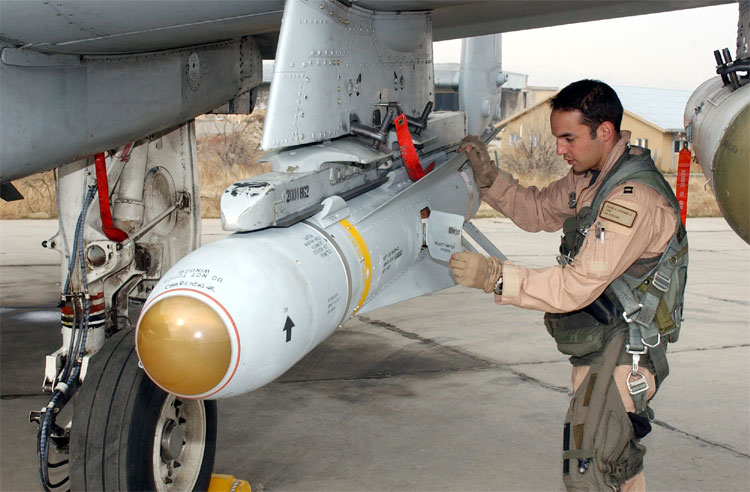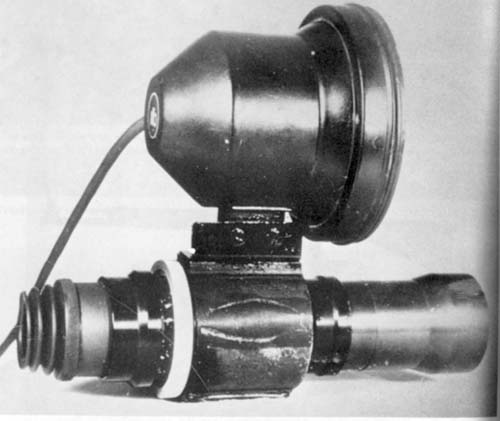|
AGM-87 Focus
The AGM-87 Focus was an air-to-surface missile developed by the United States. Overview The missile was a development of the AIM-9B Sidewinder air-to-air missile, intended for use against ground targets. Development took place at the China Lake Naval Weapons Center during the late 1960s. The infrared homing method of the Sidewinder was retained, as the missile was to be used against targets which emitted an infrared signature. Typical targets included trucks and other such vehicles. The Focus was used in Vietnam during 1969 and 1970, primarily for night attacks when IR emitters stand out well against the cool background. Although the missile was reportedly quite effective, it was discontinued in favor of other weapons. Specifications *''Length'' : 9 ft 3.5 in (2.83 m) *''Finspan'' : 1 ft 10 in (0.56 m) *''Diameter'' : 5 in (12.7 cm) *''Weight'' : 155 lb (70 kg) *''Propulsion'' : Thiokol MK 17 MOD 3 solid-fuel rocket A solid-propellant rocket ... [...More Info...] [...Related Items...] OR: [Wikipedia] [Google] [Baidu] |
Air-to-surface Missile
An air-to-surface missile (ASM) or air-to-ground missile (AGM) is a missile designed to be launched from military aircraft at targets on land or sea. There are also unpowered guided glide bombs not considered missiles. The two most common propulsion systems for air-to-surface missiles are rocket motors, usually with shorter range, and slower, longer-range jet engines. Some Soviet Union, Soviet-designed air-to-surface missiles are powered by ramjets, giving them both long range and high speed. Missile guidance, Guidance for air-to-surface missiles is typically via laser guidance, infrared homing, infrared guidance, optical guidance or via satellite guidance signals. The type of guidance depends on the type of target. Ships, for example, may be detected via passive radar or active radar homing, which is less effective against multiple, small, fast-moving land targets. There is some cross-over between air-to-surface missiles and surface-to-surface missiles. For example, there was ... [...More Info...] [...Related Items...] OR: [Wikipedia] [Google] [Baidu] |
AIM-9 Sidewinder
The AIM-9 Sidewinder is a short-range air-to-air missile. Entering service with the United States Navy in 1956 and the Air Force in 1964, the AIM-9 is one of the oldest, cheapest, and most successful air-to-air missiles. Its latest variants remain standard equipment in most Western-aligned air forces. The Soviet K-13 (AA-2 "Atoll"), a reverse-engineered copy of the AIM-9B, was also widely adopted. Low-level development started in the late 1940s, emerging in the early 1950s as a guidance system for the modular Zuni rocket. This modularity allowed for the introduction of newer seekers and rocket motors, including the AIM-9C variant, which used semi-active radar homing and served as the basis of the AGM-122 Sidearm anti-radar missile. Due to the Sidewinder's infrared guidance system, the brevity code " Fox two" is used when firing the AIM-9. Originally a tail-chasing system, early models saw extensive use during the Vietnam War, but had a low success rate (8% hit rate with th ... [...More Info...] [...Related Items...] OR: [Wikipedia] [Google] [Baidu] |
Air-to-air Missile
An air-to-air missile (AAM) is a missile fired from an aircraft for the purpose of destroying another aircraft (including unmanned aircraft such as cruise missiles). AAMs are typically powered by one or more rocket motors, usually solid-fuel rocket, solid fueled but sometimes liquid-fuel rocket, liquid fueled. Ramjet engines, as used on the Meteor (missile), Meteor, are emerging as propulsion that will enable future medium- to long-range missiles to maintain higher average speed across their engagement envelope. Air-to-air missiles are broadly put in two groups. Those designed to engage opposing aircraft at ranges of around 30 km to 40 km maximum are known as short-range or "within visual range" missiles (SRAAMs or WVRAAMs) and are sometimes called "dogfight" missiles because they are designed to optimize their agility rather than range. Most use infrared guidance and are called heat-seeking missiles. In contrast, medium- or long-range missiles (MRAAMs or LRAAMs), which ... [...More Info...] [...Related Items...] OR: [Wikipedia] [Google] [Baidu] |
Naval Air Weapons Station China Lake
Naval Air Weapons Station (NAWS) China Lake is a large military installation in California that supports the research, testing and evaluation programs of the United States Navy. It is part of Navy Region Southwest under Commander, Navy Installations Command, and was originally known as Naval Ordnance Test Station (NOTS). The installation is located in the Western Mojave Desert region of California, approximately north of Los Angeles. Occupying land in three counties – Kern, San Bernardino, and Inyo – the installation's closest neighbors are the city of Ridgecrest and the communities of Inyokern, Trona, and Darwin. China Lake is the United States Navy's largest single landholding, representing 85% of the Navy's land for weapons and armaments research, development, acquisition, testing, and evaluation (RDAT&E) use and 38% of the Navy's land holdings worldwide. In total, its two ranges and main site cover more than , an area larger than the state of Rhode Island. As ... [...More Info...] [...Related Items...] OR: [Wikipedia] [Google] [Baidu] |
Infrared Homing
Infrared homing is a Missile guidance#Passive homing, passive weapon guidance system which uses the infrared (IR) light emission from a target to track and follow it seamlessly. Missiles which use infrared seeking are often referred to as "heat-seekers" since infrared is radiated strongly by hot bodies. Many objects such as people, vehicle engines and aircraft generate and emit heat and so are especially visible in the infrared wavelengths of light compared to objects in the background. Infrared seekers are passive devices, which, unlike radar, provide no indication that they are tracking a target. That makes them suitable for sneak attacks during visual encounters or over longer ranges when they are used with a forward looking infrared or similar cueing system. Heat-seekers are extremely effective: 90% of all timeline of United States military operations, United States air combat losses between 1984 and 2009 were caused by infrared-homing missiles. They are, however, subject ... [...More Info...] [...Related Items...] OR: [Wikipedia] [Google] [Baidu] |
Infrared Signature
Infrared signature, as used by defense scientists and the military, is the appearance of objects to infrared sensors. An infrared signature depends on many factors, including the shape and size of the object, temperature, and emissivity, reflection of external sources ( earthshine, sunshine, skyshine) from the object's surface, the background against which it is viewed and the waveband of the detecting sensor. As such there is no all-encompassing definition of infrared signature nor any trivial means of measuring it. For example, the infrared signature of a truck viewed against a field will vary significantly with changing weather, time of day and engine loading. Two fairly successful examples of defining the infrared signature of an object are the apparent temperature difference at the sensor and the contrast radiant intensity (CRI) definitions. Apparent temperature difference The apparent temperature difference method of defining infrared signature gives the physical temperat ... [...More Info...] [...Related Items...] OR: [Wikipedia] [Google] [Baidu] |
Thiokol
Thiokol was an American corporation concerned initially with rubber and related chemicals, and later with rocket and missile propulsion systems. Its name is a portmanteau of the Greek words for sulfur () and glue (), an allusion to the company's initial product, Thiokol polymer. The Thiokol Chemical Company was founded in 1929. Its initial business was a range of synthetic rubber and polymer sealants. Thiokol was a major supplier of liquid polymer sealants during World War II. When scientists at the Jet Propulsion Laboratory discovered that Thiokol's polymers made ideal binders for solid rocket fuels, Thiokol moved into the new field, opening laboratories at Elkton, Maryland, and later production facilities at Elkton and at Redstone Arsenal in Huntsville, Alabama. Huntsville produced the XM33 Pollux, TX-18 Falcon, and TX-135 Nike-Zeus systems. It closed in 1996. In the mid-1950s the company bought extensive lands in Utah for its rocket test range. Thiokol was involved in ... [...More Info...] [...Related Items...] OR: [Wikipedia] [Google] [Baidu] |
Solid-fuel Rocket
A solid-propellant rocket or solid rocket is a rocket with a rocket engine that uses Rocket propellant#Solid chemical propellants, solid propellants (fuel/oxidizer). The earliest rockets were solid-fuel rockets powered by gunpowder. The inception of gunpowder rockets in warfare can be credited to the ancient Chinese, and in the 13th century, the Mongols played a pivotal role in facilitating their westward adoption. All rockets used some form of solid or powdered propellant until the 20th century, when liquid-propellant rockets offered more efficient and controllable alternatives. Because of their simplicity and reliability, solid rockets are still used today in military armaments worldwide, model rockets, solid rocket boosters and on larger applications. Since solid-fuel rockets can remain in storage for an extended period without much propellant degradation, and since they almost always launch reliably, they have been frequently used in military applications such as missiles. ... [...More Info...] [...Related Items...] OR: [Wikipedia] [Google] [Baidu] |
Air-to-surface Missiles Of The United States
An air-to-surface missile (ASM) or air-to-ground missile (AGM) is a missile designed to be launched from military aircraft at targets on land or sea. There are also unpowered guided glide bombs not considered missiles. The two most common propulsion systems for air-to-surface missiles are rocket motors, usually with shorter range, and slower, longer-range jet engines. Some Soviet-designed air-to-surface missiles are powered by ramjets, giving them both long range and high speed. Guidance for air-to-surface missiles is typically via laser guidance, infrared guidance, optical guidance or via satellite guidance signals. The type of guidance depends on the type of target. Ships, for example, may be detected via passive radar or active radar homing, which is less effective against multiple, small, fast-moving land targets. There is some cross-over between air-to-surface missiles and surface-to-surface missiles. For example, there was an air-launched version of the Tomahawk missi ... [...More Info...] [...Related Items...] OR: [Wikipedia] [Google] [Baidu] |




